
A global movement toward carbon neutrality, which calls for greenhouses gas emissions to be reduced to net-zero in order to prevent global warming, is accelerating.
Amid widespread demand for the setting and realization of carbon-neutral targets across all types of business and industries, companies are addressing the question of how to take the first step. This article discusses carbon neutrality basics and the measures needed to achieve the targets, with examples.
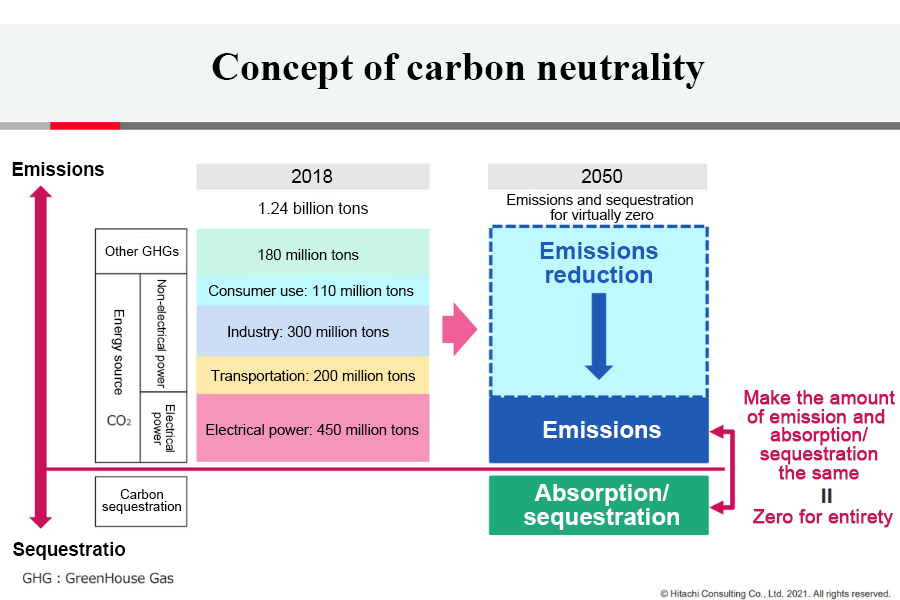
Recently, the term "carbon neutrality" is finding a place in the common lexicon. The following is a brief review of the basics of carbon neutrality.
Carbon neutrality means that the total obtained by subtracting the amount of carbon absorption and sequestration by forests from the amount of greenhouse gas (such as CO2) emissions is made to equal zero.
Reducing greenhouse gas emissions to zero is in reality fraught with difficulties. The carbon neutrality concept therefore comes down to the aim attaining "net-zero" by offsetting unavoidable emissions with absorption and sequestration.
In Japan, in October 2020, then-Prime Minister Yoshihide Suga gave a general policy address in which it was stated that "we hereby declare that by 2050 Japan will aim to reduce greenhouse gas emissions to net-zero, that is, to realize a carbon-neutral, decarbonized society." Globally, there are currently over 120 countries and regions that have set forth the target of carbon neutrality by 2050.
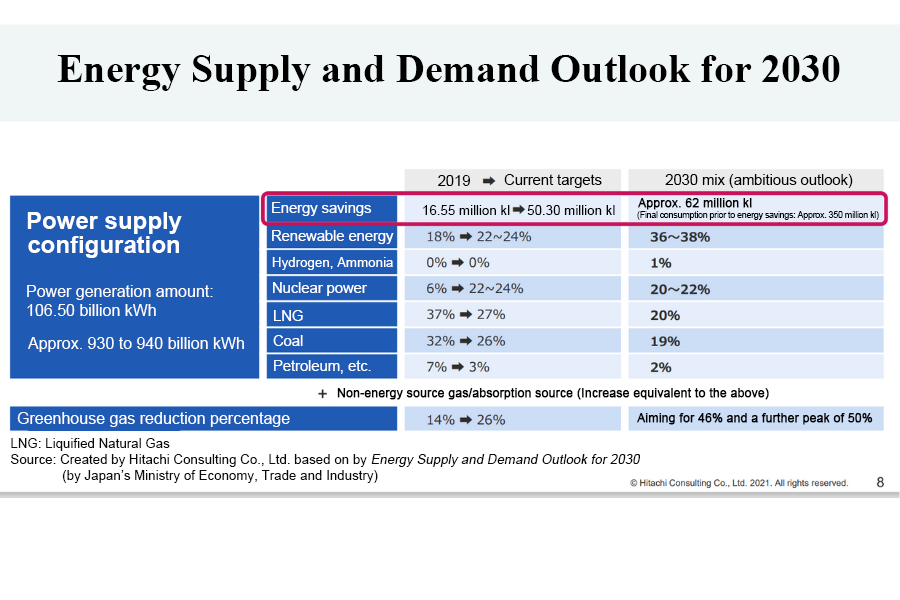
In order to achieve carbon neutrality, the extent to which the total amount of greenhouse gas emissions produced by society can be reduced will be important.
In July 2021, Japan’s Ministry of Economy, Trade and Industry released its Energy Supply and Demand Outlook for 2030, which is based on greenhouse gas reduction targets. According to this document, reductions via energy savings, i.e., reducing energy consumption itself, has greater weight than the use of renewable energy, nuclear power, liquefied natural gas, or other energy sources.
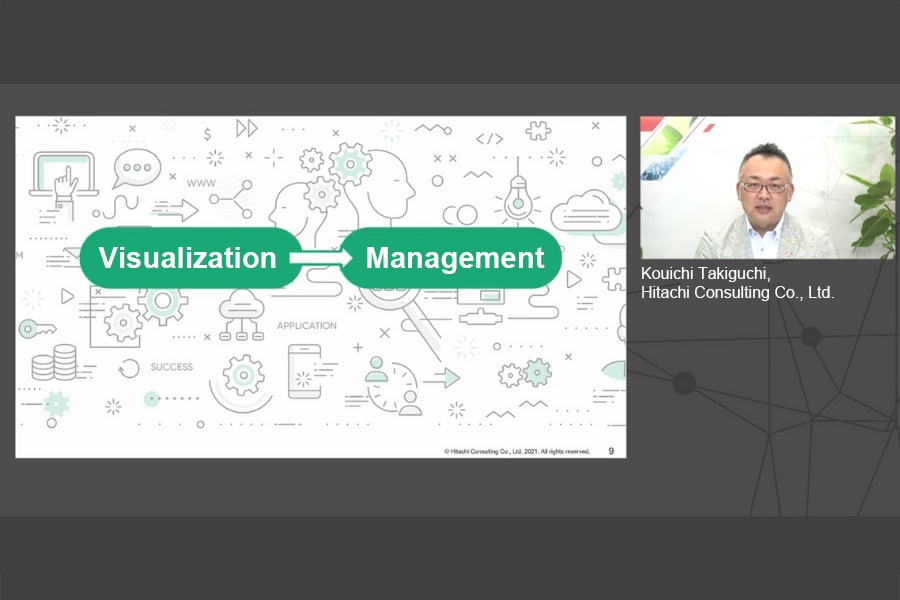
Kouichi Takiguchi of Hitachi Consulting presenting explanations online
Kouichi Takiguchi of Hitachi Consulting Co., Ltd. points out that any carbon neutrality initiative by companies must start with energy savings.
He said that "For companies to become carbon neutral, first they must start by visualizing how much energy the company is using. This should be followed by considerations on methods of energy use management. This is the first step."
The question is: How should a company work on visualization in order to reduce greenhouse gases?
Many companies already visualize the amount of their direct greenhouse gas emissions produced through the use of electricity and other such activities. However, based on ESG investment trends, it will be necessary in the future to perform management that covers up to the amount of greenhouse gas emissions generated in the supply chain process, including raw materials production, and transport.
This means that it will be necessary to visualize greenhouse gas emission amounts that include the supply chain as well as the company. To achieve this, companies will have to implement systems for cross-department data collection while integrating and managing data for the entire supply chain.
Takiguchi also pointed out that creating energy reduction plans based on visualized data and that changing ordinary daily work will be important toward achieving carbon neutrality. He said:
"Carbon neutrality is not far removed from business. In fact, methods for realizing carbon neutrality are a familiar part of company activities. Deploying multiple measures following the development of general policies, the diagnosis of the current situation, and the setting of mid- and long-term targets are important to the promotion of carbon neutrality."
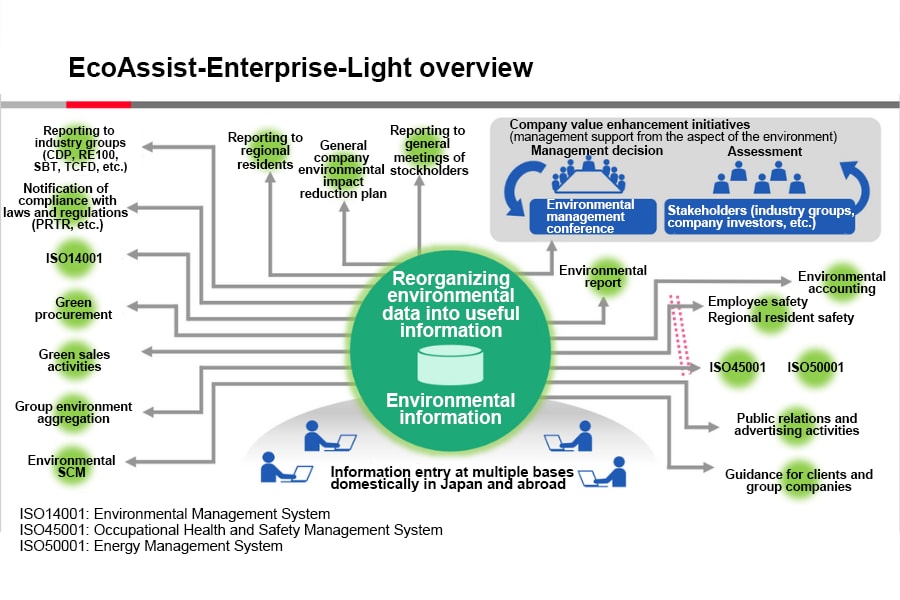
This situation is bringing attention to Hitachi's environmental information management system, EcoAssist-Enterprise-Light (hereinafter referred to as "EcoAssist"), a service that visualizes energy used throughout the entire supply chain, leading to concrete measures.
EcoAssist is a cloud-based service that gathers various types of energy data, such as CO2 emissions, and provides for centralized management. With EcoAssist, environmental reports can be semi-automatically created using collected data residing in the cloud, thereby greatly reducing the work involved in greenhouse gas calculations. EcoAssist also provides consulting services, such as the use of visualized data and the development of reduction plans.
The number of companies adopting EcoAssist has surpassed 80 and one of them is a manufacturing company with over 100 bases worldwide. In the past, this company used Microsoft Excel to track the energy data of multiple bases, but this incurred enormous man-hour needs, and it left the company grappling with such challenges as the complication of quality control and the problem of only certain people being able to do the work.
To address this, the company introduced EcoAssist, which is capable of information aggregation using a database function without changing the Excel format. As a result, the company was able to improve calculation efficiency and accuracy and to reduce the time needed for information disclosure.
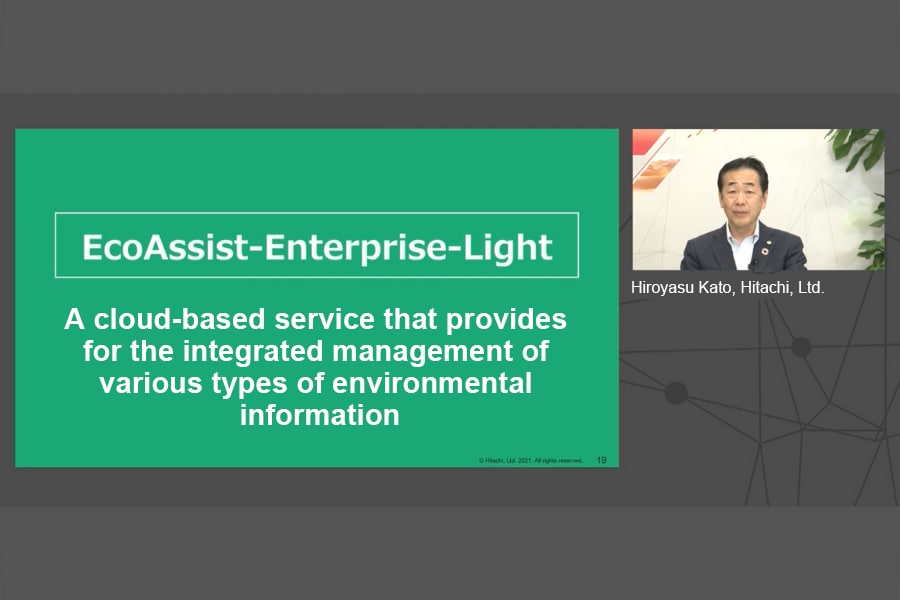
Hiroyasu Kato of Hitachi, Ltd. presenting explanations online
Hiroyasui Kato of Hitachi, Ltd. and who participated in the development of EcoAssist explained the EcoAssist usage points as follows:
"The scope of EcoAssist covers a wide range, including energy use, CO2 emissions, waste, effective use of resources, and environmental impact. Recently, there have been additional moves to expand the scope to encompass ESG investment themes, including data on governance, health and safety, and social contribution. Carbon neutrality requires long-term initiatives for setting targets and managing performance based on data. I think EcoAssist is useful in that sense as well."
So far, where companies can start and how they can work toward carbon neutrality have been discussed with examples.
The first step toward carbon neutrality starts with the visualization of energy. The next step is to consider how to reduce energy and achieve the targets.
As countermeasures to climate change take on urgency, companies are being called on to take action exceeding that taken so far.
Takiguchi stressed that it will be critical for companies and society to join forces in pursuit of the aim of achieving carbon neutrality.
"Carbon neutrality is not only a CSR (corporate social responsibility) issue—it must not be detached from business. It is incumbent upon us to take the first step and to then work together to create a sustainable future."
(This article was produced based on the contents of a lecture given at Hitachi Social Innovation Forum 2021 JAPAN, an event organized by Hitachi, Ltd. and held in October 2021.)